Story-Composing
Collection of Cultural Assets
-
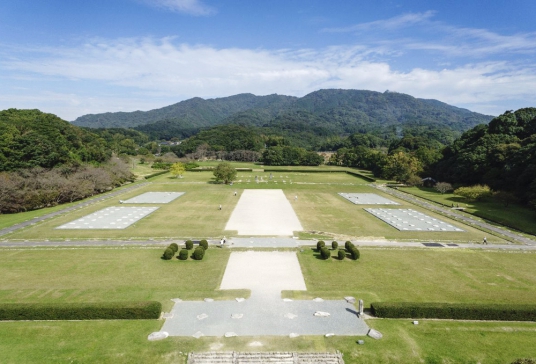
Dazaifu Government Office Ruins
【National Special Historical Site】This was the center of politics and culture in Kyushu, and also the core of Dazaifu, which was at the frontier of Japanese diplomacy and defense. Established 1300 years ago, it is composed of a government office built in Chodo-in style (similar to Heijo-kyu Palace), related offices and a guest house used to welcome foreign delegations. Many of the officials assigned to Dazaifu were those who actively worked in the international arena, such as Japanese envoys to the Tang Dynasty. This place offers a perfect setting where visitors can lose themselves in an ancient era.
More -
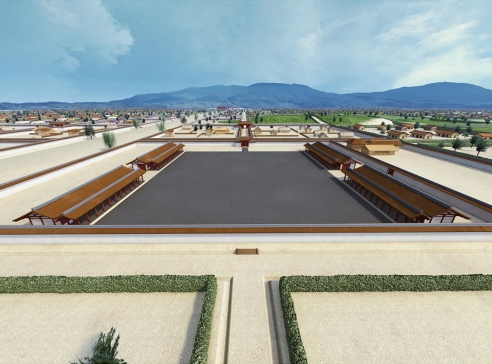
Kyakukan Guest House Ruins
【National Special Historical Site】Ancient Dazaifu was the center of politics and culture in Kyushu, and the frontier for foreign defense of Japan. Moreover, on behalf of the Imperial Court, it welcomed foreign delegates and conducted trade. For this reason, Kyakukan Guesthouse for foreign delegates were built in this city as well.
More -
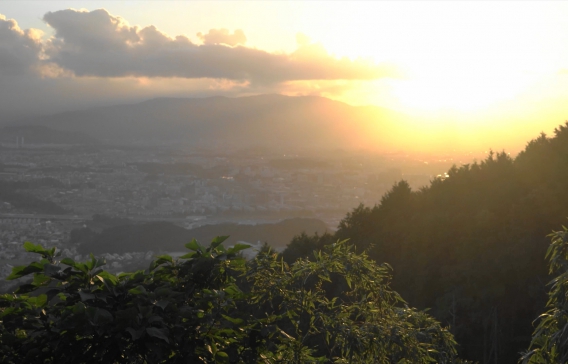
Onojo Fortress Ruins
【National Special Historical Site】This ancient mountain fortress was built 1350 years ago (665 AD) in cooperation with nobles who defected from the Baekje Kingdom (one of the ancient nations of the Korean Peninsula). The fortress was built to take advantage of a beneficial and natural landform. It is comparable to the Buso-Sanseong Mountain Fortress in Buyeo, the capital of Baekje, and shows us, along with the Mizuki Ruins and others, how Baekje castles would have appeared. Visitors to this site can enjoy panoramic views of Dazaifu and on clear days the view extends to the distant Genkai Sea.
More -
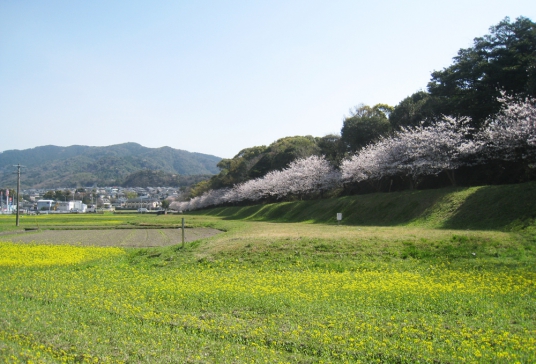
Mizuki Fortress Ruins
【National Special Historical Site】This fortress was built to defend Japan after losing the war in support of the Baekje kingdom against Tang and Silla dynasties 1350 years ago.It consists of moats filled with water and mounds. Even now, a huge mound with a length of 1.2 km can be seen. It was built in the style of the Naseong city wall in Buyeo, capital of Baekje. Later, it became the entrance to Dazaifu, which welcomed many foreign delegations and government officials from the national capital. This was the setting for a number of stories from history.
More -
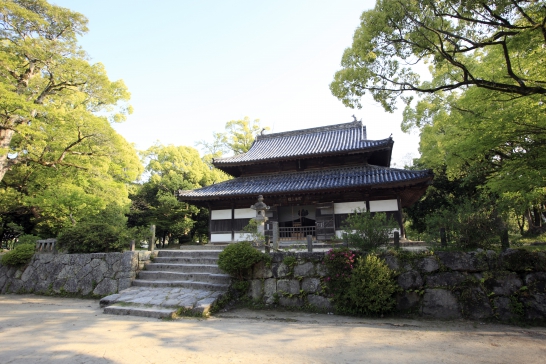
Kanzeon-ji Temple・Kaidan-in Temple
【National Historical Site(Kanzeonji precinctand sub-temples ruins,attached Roji tile kiln ruins)National Important Cultural Property(Sculpture)Prefecturally Important Tangible Cultural Property(Architecture・Craft)】This temple was built in the memory of the late Empress Saimei by her son, Emperor Tenji. There were as many as 49 sub-temples in the area, and even now foundation stones from temple buildings remain, giving evidence to the prosperity of this temple in ancient times. The temple had a Bugaku band that played music and performed dances that originated on the continent. Some masks of Bugaku Ryoo and Nasori (a nationally important cultural property) still remain. Also remaining is a burial mound for Priest Genbo, who conducted the Buddhist memorial service that marked the completion of the temple. Ganjin, a priest of the Tang dynasty and Kukai a priest who went to the Tang dynasty stayed here. The first commandments of Japanese Buddhism were likely delivered here, helping to make this temple one of the three official ordination halls in Japan. An ordination hall still operates at Kaidan-in. The 16 Buddhist statues placed in the temple (nationally important cultural properties) were sophisticated images made during the Heian and Kamakura periods, indicating that Buddhist culture continued to flourish in this area.Even now, Kanzeon-ji (the Main Hall and Lecture Hall are prefecturally important tangible cultural properties) and Kaidan-in (the Main Hall, Bell Tower and Bell are prefecturally important tangible cultural properties) stand to pass down the light of Buddhism to current generations.
More -
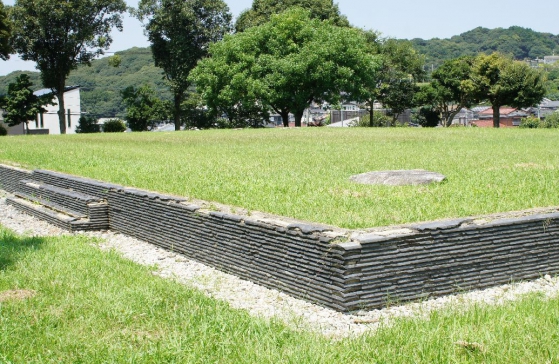
Chikuzen Kokubunji Ruins
【National Historical Site】This is one of the Kokubunji Temples constructed nationwide under the orders of Emperor Shomu. Wood tabs related to census registration were discovered around this site, suggesting that there were related facilities for Chikuzen-koku Province, such as a provincial office nearby. The surrounding landscape still retains some remnants of that era.
More -
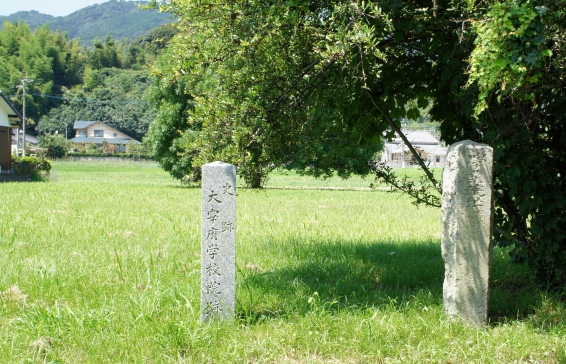
Dazaifu Gakkoin Site
【National Historical Site】This was the site of an institution used to train government officials in Dazaifu. Children of the officials working in Saikai-do (Kyushu) area studied here. Oe no Masafusa, the Provisional Governor-General of Dazaifu at that time, wrote in “Goke-shidai” (ritual protocol of the Oe family) that there was a facility that housed a portrait of Confucius that was brought back from the Tang Dynasty by Kibi no Makibi. Presently Chinese pistache trees are planted along the prefectural road. Their seeds were taken from the pistache trees at Confucius’ Mausoleum and offered by a descendant of Confucius. *Because of a typhoon in the summer of 2015, two of three Chinese pistache trees were broken.
More -
Kokubu Tile Kiln Site
【National Historical Site】This was the site of a tile kiln located northeast of the Chikuzen Kokubunji Temple site. It was a climbing kiln that used adobe for the walls and ceiling. This kiln was thought to have been used in the mid-8th century, and the founding tiles for Chikuzen Kokubunji Temple were most likely fired here.
More -
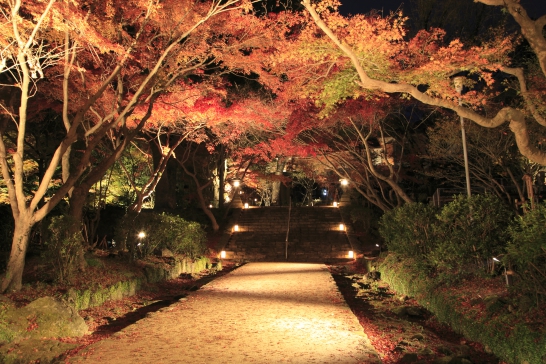
Mt. Homan
【National Historical Site】This beautifully shaped 829meter mountain in the northeast of Dazaifu was once called Mt. Mikasa. From the Nara period, national border rituals were carried out on this mountain. According to one record, Saicho sculpted a Yakushi Buddha statue here before going to Tang China, praying for a safe sea voyage. After returning, he set out to build six pagodas in Japan; and the Anzai Pagoda was built here. During the middle ages, a temple and administrative office for Dazaifu were built here, and trade with foreign countries was conducted. Now it is the site of Kamado Shrine, and it conveys the flavor of the ancient rituals conducted on the mountain.
More -
Bonsho Bell
【National Treasure】This is the oldest bell in Japan, belonging tothe bell tower of Kanzeonji Temple. This is the very bell that Sugawara no Michizane wrote about in a Chinese-style poem titled “Mon wo Idezu”. It is still used today, and rings as clearly as it did in ancient times.
More -
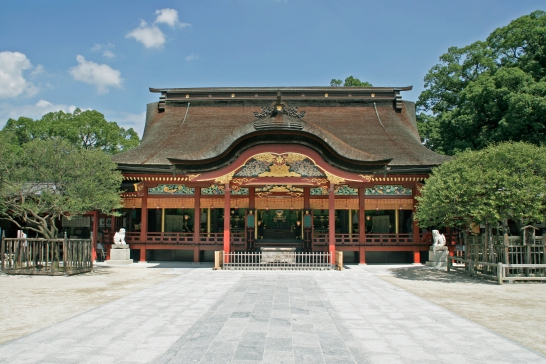
Dazaifu Tenmangu Shrine
This site features a mausoleum for Sugawara no Michizane, who died in Dazaifu while serving as Provisional Governor of Dazaifu. It was also called Tenmangu Anrakuji Temple. In the Heian period (794-1185), various events, including Kyokusui no En, that originated from the continent were held here, and some are still conducted today. Michizane was revered as a man of culture, and so many nobles and samurais visited the shrine. It became a sacred spot for literature, and linked verses have been dedicated to the shrine. A copy of a book published during the Tang Dynasty called “Kan-en” was transcribed during the Heian period, and is preserved here. (This is considered a national treasure.)During the Kamakura period (13 century), Koyu, an envoy from Goryeo, visited the shrine and dedicated a poem to it. The Main Shrine is designated as a nationally important cultural property. The shrine, in combination with the traditional events practiced here, allowvisitors to experience the atmosphere of an ancient era.
More -
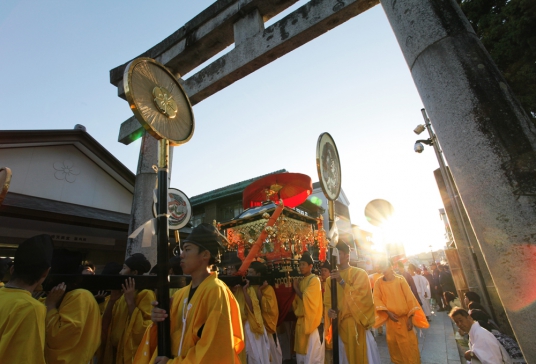
Dazaifu Tenmangu Shrine Jinko Event
The Jinko event was started by Oe no Masafusa, Provisional Governor-General of Dazaifu in the Heian period (1101). Every year in September, a procession of portable shrine proceeds on the roads following the land allotments of ancient times, between Dazaifu Tenmangu Shrine and the Dazaifu South Hall Site (present-day Enokisha Shrine), where Sugawara no Michizane lived in exile. This Jinko procession is accompanied by about 400-700 people dressed in period costumes and escorting a portable shrine.
More -
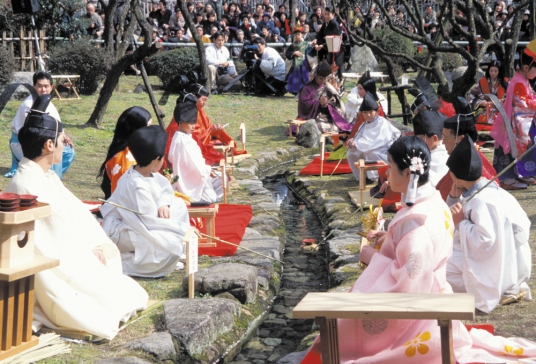
Traditional Events of Dazaifu Tenmangu Shrine
Many annual events of the Imperial Court were transferred to Dazaifu by senior government officials during the Heian period (794-1185), and they were conducted in front of Tenman-Tenjin deity. They were called Shido no En. Among these, Kyokusui no En with its origin in the continent, as well as Tanabata no En and Zankiku no En are still practiced today. At these events, poems including Chinese-style poems are created.
More -
Man'yoshu Tsukushi Kadan
Out of 4500 poems included in the Man'yoshu anthology, approximately 320 of them were written in the Tsukushi region (now Fukuoka province). Renowned poets stayed in Dazaifu during the Jinki and Tenpyo years (724-748) of the Nara period, and wrote poems that were included in the Man'yoshu. The poems created at a plum-blossom party hosted at the residence of Otomo no Tabito, the Governor-General of Dazaifu, are especially famous. In those times, plums were still-new novelties brought over from the Tang Dynasty.
More -
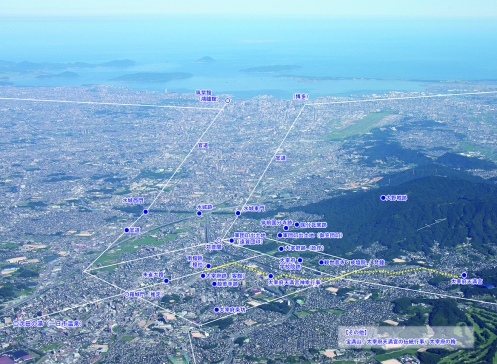
Site of Dazaifu Jobo (Grid based city)
This was the site of a town with land allotted in the grid pattern that was adopted by capitals of East Asia during ancient times. It was built during the Asuka period. In the Nara period, the Government Office and Suzaku Road were constructed. It resembled Heijokyo, modeled after Chang'an of the Tang Dynasty. An official in charge of Heijokyo designed and constructed the Town. There are still land allotments that leave traces of the Jobo in various places around the city.
More -
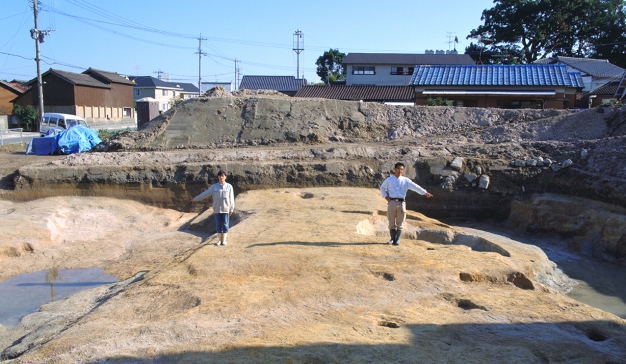
Kando (National Road)
These straight roads pass through the West Gate and East Gate of Mizuki, an entrance to Dazaifu. The West Gate route linked Tsukushi-no-murotsumi (the site of Korokan guesthouse) and Dazaifu, and was used by foreign delegations on their way to Dazaifu. The East Gate route connected to Hakata and was used by government officials assigned from the national capital. Both the West Gate and East Gate routes are now used as city roads.
More -
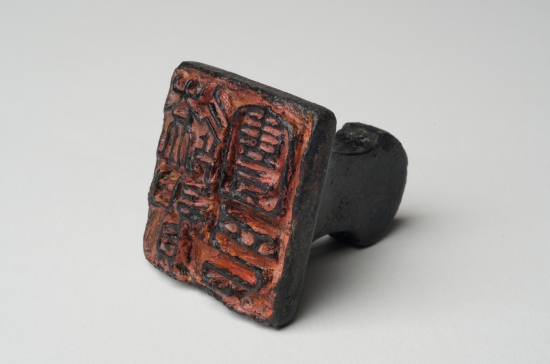
Archeological location site of the Corps Seals
In Chikuzen-koku Province, where Dazaifu was located, there were four army corps deployed. This is where the bronze seals of two of them (the Mikasa Corps Seal and Oka Corps Seal) were discovered. Both are nationally important cultural properties. This site stands at the northwestern edge of the Dazaifu Jobo, and the seals tell us that army corps were stationed here to protect Dazaifu and Chikuzen-koku Province.
More -
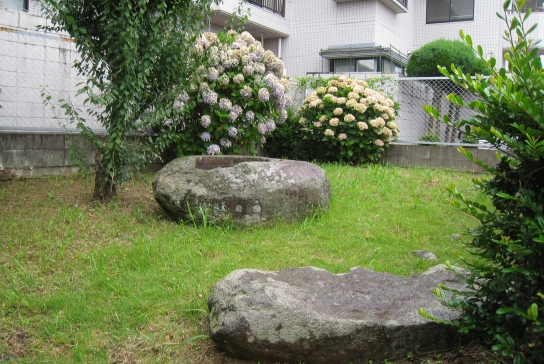
Hannyaji Temple Ruins
This ancient temple is thought to have been built by Soga no Himuka, the Governor of Tsukushi-Dazaifu, in the hope that it would help Emperor Kotoku recover from an illness in 654.. It was moved to inside the Dazaifu Jobo during the Nara period. In that era, the only temples inside the Jobo were Kanzeonji Temple, Hannyaji Temple which were connected to the Emperor. A foundation mound and a foundation stone for a central pillar of a pagoda have been discovered here. There is still a seven-story stone pagoda here that was built during the Kamakura period (national important cultural property).
More -
South Hall Site
The hall was an official residence for officials who were transferred from the national capital. The South Hall is known as the place where Sugawara no Michizane lived while in exile. After that, Fujiwara no Korenori, the Senior Governor of the time, built Jomyo-in Shrine to console the spirit of Michizane in 1023. In 1101, Oe no Masafusa, Provisional Governor of Dazaifu, started a Jinko procession linking this place and Tenmangu. This site is now home to Enokisha Shrine. There is a Kyakukan (guesthouse for foreign delegations) site nearby, and this area offers an image of how Suzaku Road appeared in ancient times.
More -
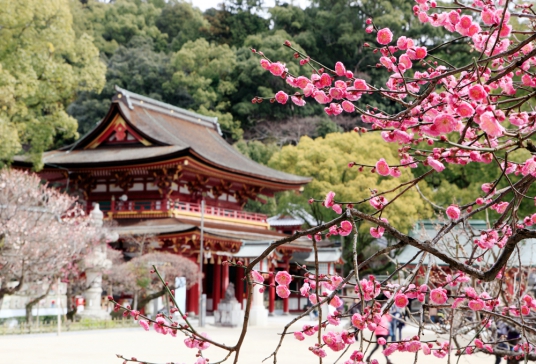
Dazaifu Plum Blossomes
In the Nara period, plum blossoms, which bloom in spring and emit a pleasant fragrance, were seen as new and elegant trees brought in from Tang China. A plum-blossom party was described in the Man'yoshu. Plum-blossom viewing became popular in Dazaifu as well. The image of plum blossoms came to be linked to Dazaifu and Dazaifu Tenmangu, with the Tobi-ume legend and Jomyo-ni legend especially, because of Sugawara no Michizane's lifelong affection for this flower. Even today, many people plant plum trees at their houses and a traditional event to donate plums to Tenmangu is held.(The Tobi-ume (flying plum tree) legend has it that a particular tree yearned so much for Michizane that it flew overnight from Kyoto to reunite with him in Dazaifu. The one to the right of the Main Shrine is said to be this legendary tree.The Jomyo-ni legend is a story about an elderly lady who took good care of Michizane, who was forced to lead an uncomfortable life in Dazaifu, by (for example) offering baked rice cakes skewered on a plum branch. This is said to be the origin of umegae-mochi, a famous specialty cake of Dazaifu.)
More




















